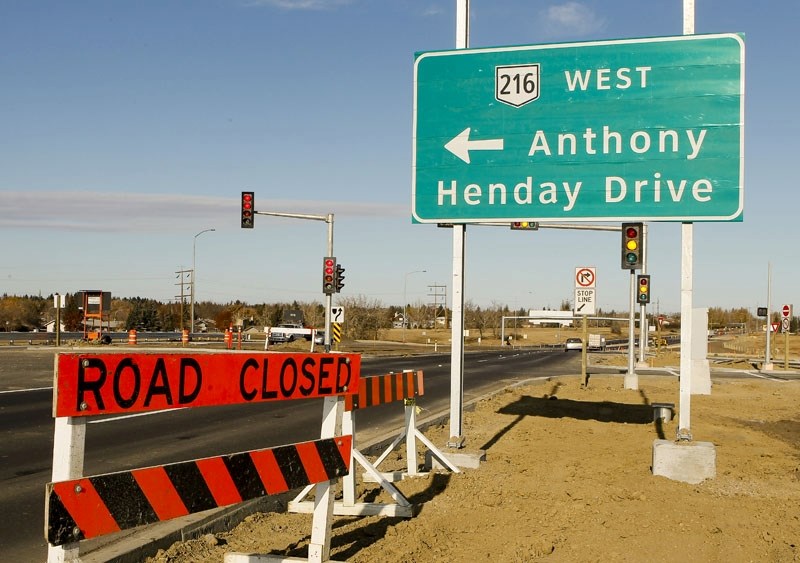It's too soon to tell what the environmental impact of the Anthony Henday will be, say observers, but it has already had some noticeable negative effects.
The northwest leg of Anthony Henday Drive opened this week. While most of its lines, signs, and on-ramps should be complete by the end of the month (see box), it will be years before it's known if its environmental measures work.
One of its most noticeable impacts was to the land itself. At four lanes wide and 21 kilometres long, its construction required the destruction of many fields, wetlands and forests.
Fewer birds
Local birder Dan Stoker says he used to find plenty of boreal chickadees and horned owls during the Edmonton Christmas Bird Count in a large stand of evergreens in northwest Edmonton — one of the few wild areas left in the heavily industrialized region.
Crews moved into the area about two years ago, he says, and felled about half the forest. There were no horned owls there last year, and far fewer boreal chickadees. Several stands once patrolled during the St. Albert bird count suffered similar fates. "There was nothing left."
It will be several years before the effect of these changes on bird populations can be properly gauged, Stoker says, but he suspects they will be major in these areas. "There are certain forests that are gone now, and there will be no birds there."
More wetlands?
Any new road in Alberta has a good chance of cutting through an existing wetland, says Dee Patriquin, an environmental scientist with Spencer Environmental Management Services and a consultant on the northwest leg of the Henday. Wetlands are considered important water filters and habitat for many animals and building this leg of the Henday eliminated about 35 hectares of wetland.
However, crews working with Spencer Environmental dug up the affected wetlands during construction and stockpiled the fertile soil for later use, says James Herian, construction manager for this leg of the Henday. They later used that soil to build about 196 hectares of wetland and upland native grasslands around the Henday to replace what was lost.
"We never really deleted any wetlands," he says. "They just got relocated."
Crews still have one stormwater pond and some seeding to finish next spring, Patriquin says. Some of the restored plants have already sprouted, and frogs and Canada geese have been spotted in some of the wetland regions. "It's promising."
This is a vast amount of wetland restoration for an urban area, Patriquin says, and most of it will be preserved in perpetuity since land use in a transportation utility corridor is highly restricted, and almost all the development around the Henday is now complete.
Still, it will be years before it's known if these wetlands provide the same ecological performance as the originals, she says.
"They're not going to be equivalent right off the bat, but over time, they certainly can be."
Crews will monitor and adjust the wetlands as needed for the next five years, she adds.
Rare plants conserved
Patriquin says the Henday also threatened several stands of parasol white-aster (up to two metres tall, one stem, umbrella of white flower-heads), smooth-sweet cicely (a metre tall, smells like liquorice when crushed) and back-turned sedge — all rare plants found in fewer than 20 places in Alberta. Two of these stands had already been moved to make way for Ray Gibbon Drive.
These were easy to save, Patriquin says, as crews knew exactly where they were. Crews dug up some of these plants in 2008 and transplanted them to protected locations such as Kirk Lake. "With all the rainfall we've had, I expect they're doing a lot better than they did in 2009 and 2010."
Call 1-888-220-2335 for any questions on the Henday.
It's almost done
o The northwest leg of the Henday should be completely finished by the end of the month, says deputy project manager Mark Basher. Campbell Road was mostly done as of Friday, with one last off-ramp scheduled for completion next week. Crews hope to have the lines painted on 137 Ave., 97 St., and the 195 Ave. flyover by Monday.
o Watch for two road closures in the near future - 97th St. will be closed to northbound traffic tonight so crews can install an overhead sign, while St. Albert Trail will be closed southbound on the night of Nov. 12 for similar reasons.
o 167 Ave., a road near the Henday used by many as a shortcut into Edmonton, should be open by Nov. 11, says Jason Meliefste of the City of Edmonton.




